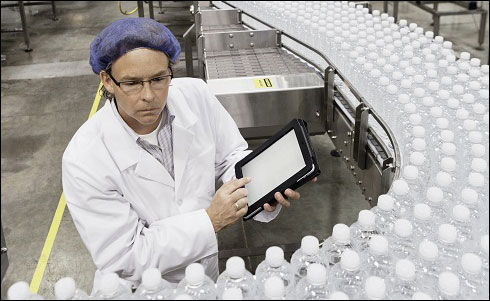5 Things to Know about Machine Diagnostics and the IIoT
Many industrial processes use devices with sensing technology to perform automated tasks with efficiency and precision. With the increase in complexity of manufacturing processes, however, comes the opportunity for things to go wrong – especially with a limited human presence in most industrial applications.
Many industrial processes use devices with sensing technology to perform automated tasks with efficiency and precision. With the increase in complexity of manufacturing processes, however, comes the opportunity for things to go wrong – especially with a limited human presence in most industrial applications.
Now, as these applications get smarter and smaller, even the sensors have sensors.
The ability of these components to provide diagnostics and feedback has already become critically important. When a fault occurs – whether it’s flagged by a specific sensor or in a component itself – minimizing downtime becomes equally critical.
I was recently asked by Control Design magazine to share my thoughts about the current state of sensors, as well as the benefits of their use in the application of emerging technologies. Let’s take a look at how machine diagnostics are changing to meet the needs of Industrial Internet of Things (IIoT) applications.

One example is using smart sensors and remote monitoring technology to identify an error on a water bottle packaging line.
1. How Can Sensing Technologies Contribute to Better Machine Diagnostics, in Particular, Troubleshooting Issues?
Sensors are absolutely key in diagnosing machine problems.
Position sensors, for example, are very common in most machines. They’re the sensors that guide items through a process, whether that’s handling and moving materials through a conveyor system, assembly line, packaging process or manufacturing process control. Position sensors allow the system to identify jams or other faults that might prevent the item from completing the process.
Other types of sensors can also provide useful feedback for locating a fault within a machine. Smart sensors or actuators – those that provide additional digital information about the function and health of the sensor itself – can further assist with troubleshooting by eliminating the sensor itself as the source of the fault.
Smart sensors/actuators also improve network uptime by providing engineers with health information that can be used to perform preventive maintenance before a component failure causes a system downtime incident.
2. What Impact Does Remote Connectivity Have on Detecting, Diagnosing and Correcting Machine Problems?
Augmented reality (AR) and virtual reality (VR) are the pinnacle of system diagnostics. If a system engineer can identify the exact location of a fault by simply using a handheld device to scan a machine, then that failed component can be replaced immediately.
Oftentimes, identifying the failed component is the most time-consuming part of the troubleshooting process – and it can take hours. AR/VR, however, reduces that time to minutes!
Not only does this save companies’ time, it also reduces the downtime costs associated with failed components. Every industry needs to run at maximum uptime and capacity. New technologies, like AR and VR are another way to help get us there.
3. Do Things Like Augmented Reality or Virtual Reality Play a Role in Machine Diagnostics?
Remote, or on-machine, connectivity offers distinct advantages over central, or “home-run,” wiring.
Distributed fieldbus I/O systems create a sort of segmented repair environment. By having the connections housed on-machine, fault locations can be isolated to specific devices and locations within a machine – allowing maintenance workers to replace or repair malfunctioning cordsets or devices at the source.
This means a machine can be back up and running in minutes because of the modular nature of the repair. Also, initial installation can be up to four times faster than “home-run” wiring.
4. How Has Technology Evolved to Enhance a Devices’ Ability to Collect and Monitor Information on Environmental Factors?
Innovations in sensor technology occur constantly. High resolution cameras, microelectromechanical systems (MEMS) technology and other advanced technologies are being incorporated into smart input and output devices all the time.
These advances allow for devices that can predict their own failure or report a need for calibration or other adjustments. The sheer volume of information that these devices can provide could overwhelm the computing power of a centralized control system.
Instead of increasing the computing power and cost of the central control system, distributed control with lower cost devices allows systems to handle and act on the large amount of data provided by these smart systems.
As we move into the era of the 4th Industrial Revolution or Industrie 4.0, these distributed control units (DCUs) will be critical in implementing a highly configurable system that can be easily reconfigured as changes occur.
5. What’s Happening With Machine Diagnostic Tools Today?
In order to compete in the world economy, systems must be highly automated and able to function with little human input, or ideally, none at all.
Diagnostic systems are critical to reducing downtime and allowing systems to run “lights out.” Today’s manufacturing environment has accelerated the development of diagnostic tools, making them a must-have.
Diagnostic tools will need to be able to gather and process the vast amounts of data available from smart I/O devices, and even standard sensors. Then, taking it one step further, they need to use advanced analytics to predict component failures and set preventative maintenance schedules. These diagnostic tools will reduce unplanned downtime incidents and allow companies to maximize profits.
![System.String[]](https://assets.belden.com/transform/7d9664bf-965d-4965-a32d-382a9829c061/Author-Belden-Logo-sm-blue-2020-10?io=transform:fill,width:300,height:300)